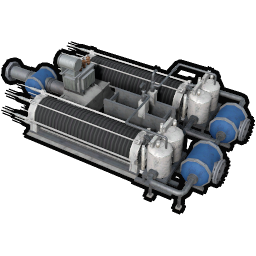Difference between revisions of "Electrolyzer"
Thadius856 (talk | contribs) m (→�: remove unused tier/image params) |
Thadius856 (talk | contribs) m (implement {{infoicon}}) |
||
| Line 15: | Line 15: | ||
| Variants = | | Variants = | ||
}} | }} | ||
The '''Electrolyzer''' is the sole machine capable of creating | The '''Electrolyzer''' is the sole machine capable of creating {{infoicon|Chlorine}} for the processing of {{infoicon|Waste Water}} in [[Wastewater Treatment]] facilities and the production of {{infoicon|Plastic}} in [[Polymerization Plant]]s. | ||
It is also the only machine able to make | It is also the only machine able to make {{infoicon|Hydrogen}} without additional byproducts that cause [[Pollution]], making it a critical component in [[Heavy Oil Cracking]] systems, {{infoicon|Fuel Gas}} [[Fuel Gas Synthesis|synthesis]], the production of {{infoicon|Silicon (Poly)}} for {{infoicon|Electronics}}, and {{infoicon|Uranium Pellets}} for creating {{infoicon|Uranium Rod}}s to power [[Nuclear Reactor]]s. This machine is capable of breaking down {{infoicon|Ammonia}} into {{infoicon|Nitrogen}} and {{infoicon|Hydrogen}} which allows for Pollution-free [[Flare|flaring]]/[[Smoke Stack|venting]] of the constituent parts. | ||
==Comparison to the Air Separator== | ==Comparison to the Air Separator== | ||
The Electrolyzer is capable of generating | The Electrolyzer is capable of generating {{infoicon|Oxygen}} by splitting {{infoicon|Water}}, though it is vastly outclassed by the [[Air Separator]], which can create it directly from the atmosphere, in nearly every metric. Comparatively, it requires nearly double the [[Electricity]] requirement (150 KW vs 80 KW), produces a fraction of the output (1.5 /60s vs 24 /60s), and requires both {{infoicon|Steel}} and {{infoicon|Construction Parts III}} production lines (or [[trading]]) to erect. However, the Electrolyzer carries a smaller footprint (5x4 vs 9x6) when input piping is not considered, which makes it potentially viable for this Oxygen generation in niche cases where very both low output is acceptable and build space is very limited. | ||
==Recipes== | ==Recipes== | ||
Revision as of 05:42, 22 January 2022
| Construction | |
| Workers | |
| Electricity | |
| Maintenance | |
| Footprint | 5x4 |
| Required Research | Electrolysis |
| Designation | General Machines |
The Electrolyzer is the sole machine capable of creating Chlorine for the processing of Waste Water in Wastewater Treatment facilities and the production of Plastic in Polymerization Plants.
It is also the only machine able to make Hydrogen without additional byproducts that cause Pollution, making it a critical component in Heavy Oil Cracking systems, Fuel Gas synthesis, the production of Silicon (Poly) for Electronics, and Uranium Pellets for creating Uranium Rods to power Nuclear Reactors. This machine is capable of breaking down Ammonia into Nitrogen and Hydrogen which allows for Pollution-free flaring/venting of the constituent parts.
Comparison to the Air Separator
The Electrolyzer is capable of generating Oxygen by splitting Water, though it is vastly outclassed by the Air Separator, which can create it directly from the atmosphere, in nearly every metric. Comparatively, it requires nearly double the Electricity requirement (150 KW vs 80 KW), produces a fraction of the output (1.5 /60s vs 24 /60s), and requires both Steel and Construction Parts III production lines (or trading) to erect. However, the Electrolyzer carries a smaller footprint (5x4 vs 9x6) when input piping is not considered, which makes it potentially viable for this Oxygen generation in niche cases where very both low output is acceptable and build space is very limited.
